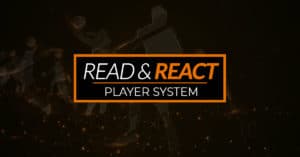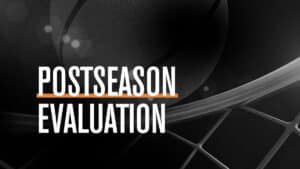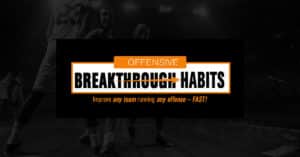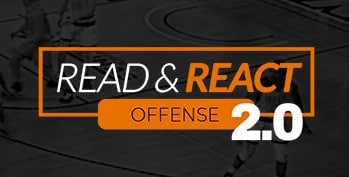One of the advantages of the Read & React is that it can ease communication between coaches and players. It can also ease communication between coaches and other coaches (as long as they are in the Tribe).
So, with that in mind and as an expansion of our previous post, A Cut By Any Other Name, here’s a list of Read & React Terminology.
Natural Pitch – This is an air pass. It is the most natural pass to make when a player drives to the basket and is stopped and looks to pass.
Dish – This is a bounce pass, typically thrown to a cutter.
Circle Movement – When the ball drives “North-South” to the basket, perimeter players and even post players (Advanced Post Slides) must move to the next “Spot” (as defined by the offense) in the same direction that ball is driven. Ex: If the ball handler drives around their defender using their right hand, then those without the ball must move one Spot to their right. If the ball drives left, then everyone else “Circle Moves” one Spot to their left.
Safety Valve – When a player circle moves behind the driving player, he becomes a “safety valve” if the driving teammate gets in trouble.
North/South – This is when a player with the ball goes directly to the basket no wider than a “V.” Some R&R coaches call this a “Penetration Dribble”.
East/West – This is when a player with the ball moves laterally to the basket. Some R&R coaches call this a “Perimeter Dribble”. This usually occurs in one of two circumstances:
- A player tries to drive north/south, but is stopped and pushed outside the lane; this then becomes an east/west movement. This creates a “U”shaped drive rather than the intended “V” shaped drive.
- A player deliberately dribbles the ball at another teammate on the perimeter (east/west) creating a dribble-at or a power dribble (see below).
Dribble-At (formerly called: Speed Dribble) – When a player dribbles towards another teammate in an east/west dribble, thus causing the teammate who is being dribbled-at to cut to the basket.
Power Dribble – When the perimeter player with the ball turns his back to the basket and side-steps towards another player. This alerts the player without the ball to come to the ball and take a hand-off from the player who initiated the power dribble. This then turns into a “pick and roll” type play.
Reverse Dribble – When the ball handler “backs up” (toward the half-line), while still facing the goal. It is a signal for a “sprint-ball-screen” from the post player.
Circle Reverse – A “Circle Reverse is created when a player begins a drive north/south but is stopped by the defense forcing that north/south drive into an east/west movement. If the ball handler picks up his dribble (and is clearly in trouble), the nearest player stops his normal circle movement and “reverses” his movement back to help out his teammate. This is a pressure relief mechanism.
Pass & Cut – When a pass is made to a teammate an automatic cut to the basket takes place.
Front Cut – When a player passes the ball he then makes a north/south cut to the basket, cutting in “Front” of the defender, or between the defender and the player with the basketball.
Rear Cut – Same as front cut except this time he goes behind his defender. Typically used when the defense over plays and jumps between his man and the ball, a rear cut is then initiated. Some R&R coaches call this a “backdoor cut”.
Corner Comeback – When a player initiates a baseline drive (north/south) causing circle movement, the opposite corner does not circle move and stays in the corner or begins circle movement momentarily before returning to the corner (corner comeback) for the natural pitch. This is the only exception to circle movement.
Corner or Making a Corner – When a basket-cutter is blocked by their defender, the cutter can make a ninety-degree angle change of direction (thus “making a corner”) and set a screen for the closest teammate. Filling an empty spot is also an option.
Back Screen – When a player enters the lane in a north/south movement either by driving and passing or by passing and cutting, the player then can set a back screen for any teammate and take his spot as he then cuts to the basket.
Pin and Skip – When 2 players are on the weak-side one player will pick the other players defender and free up his teammate to shoot an open shot/drive/pass when a skip pass is made from the ball side.
Fill the Spot – When a player vacates a spot on the perimeter another player must fill this vacant spot with the filling of spots one pass away from the ball being the priority.
Read Line – This is the line on the court (usually the 3-point line for most teams) that serves as the “Read Line” for an automatic basket cut. That means that when a player is one pass away on the perimeter, and his defender puts even one foot onto or over the “Read Line”, that player must basket cut.
Laker cut HIGH – When a pass is made into the post the passer cuts above the post, usually through the elbow.
Laker cut LOW – When a pass is made to the post the passer cuts below the post or baseline side.
Relocate – When a pass is made to the post, the passer can relocate one spot on the perimeter for a return pass from the post. This is only an option if there is an open spot to relocate to.
X-Cut – When a pass is made to the post, the passer can go to another teammate one spot away on the perimeter and set a pick. The player receiving the screen uses the screen to fill the spot of the screener. The screener “slips” the screen and cuts to the basket.
5 OUT – All 5 players are on the perimeter and continue to fill to the perimeter after cutting to the basket.
4 OUT 1 IN – This is a typical one post set. There are 4 perimeter players and one post.
3 OUT 2 IN – This set has 2 post players and 3 perimeter players.
Reaction Habits – When a player reacts to the movement of the teammate with the ball without thinking. He moves based on the ball movement and reacts without thought. This is the ultimate goal of the Read & React.
So, there it is. All the terminology within the Read & React (maybe?). What are your thoughts? Did we miss any? Have you found that changing some of the terminology works better with your team? Let the Tribe know – it may be helpful for their teams too.






